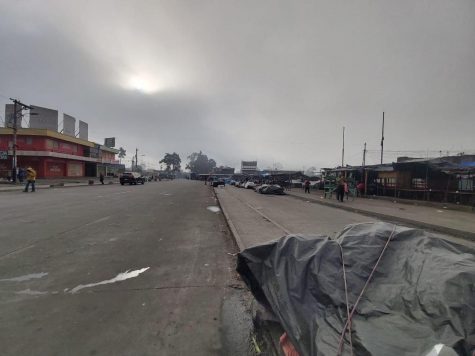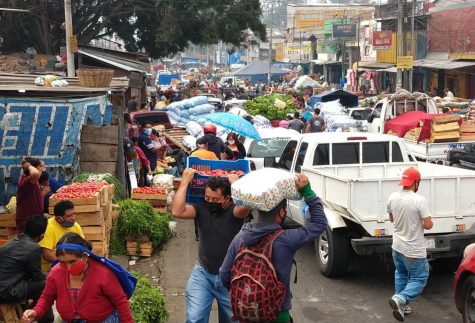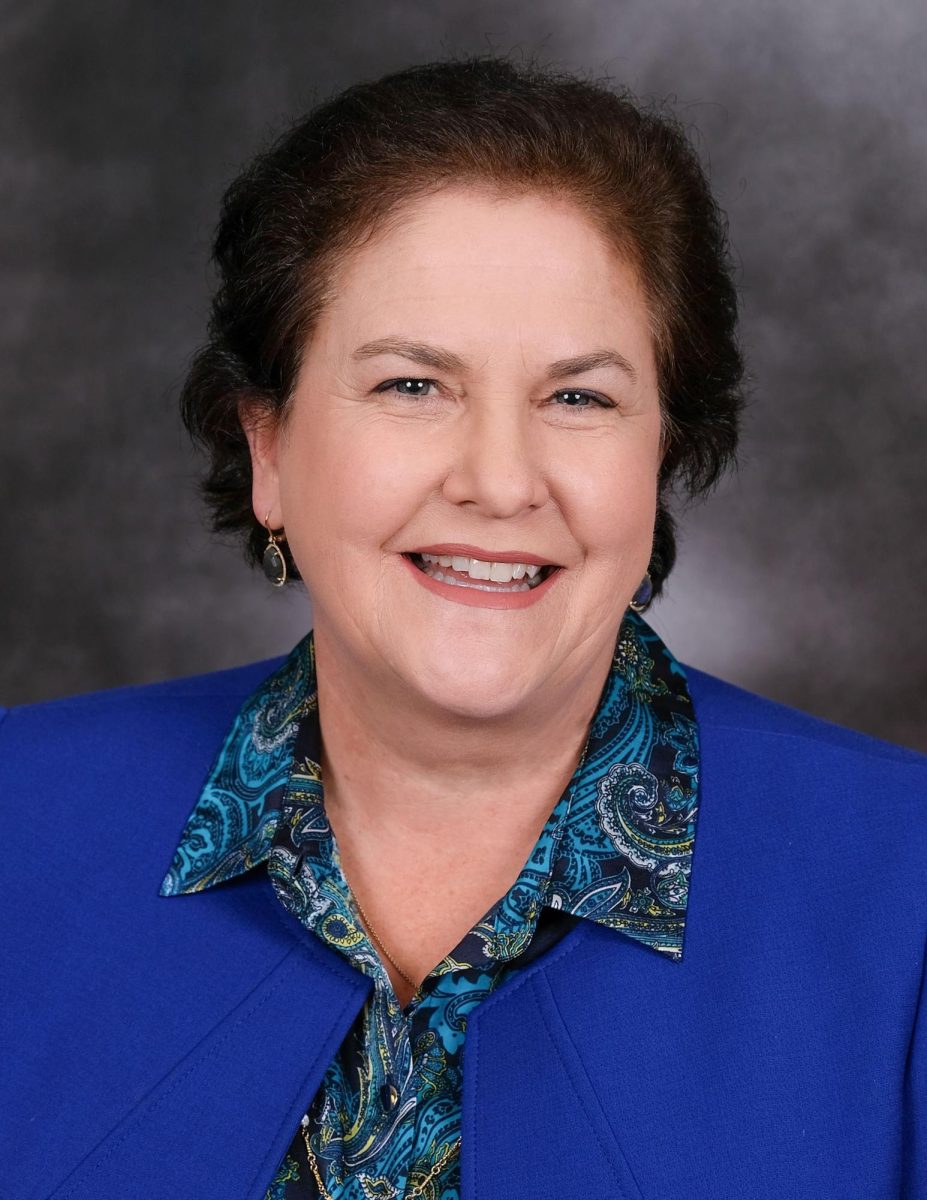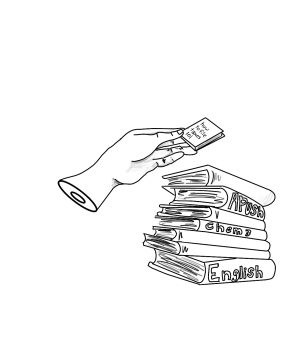Covid-19 en Paises Hispanohablantes
November 6, 2020
COVID-19 tomó a todo mundo por sorpresa, dejando a los gobiernos con decisiones grandes en cómo enfrentar este problema. Para muchos países, un toque de queda empezó durante la segunda semana de Marzo. Como los Estados Unidos, países como Panamá, Guatemala y España empezaron a implementar regulaciones como máscaras, guantes y mantener dos metros de distancia entre personas. Pero estos países también tomaron pasos más allá.
Heidy Cucum, un estudiante de la Universidad Rafael Landivar de Quetzaltenango, explica cómo COVID-19 cambió cómo vivían su vida dia a dia. Un mes después de que el primer caso positivo fue confirmado, toques de queda fueron implementados: solo una persona por familia podía salir para compras y solo había un día a la semana que personas podrían salir a ir al banco o mercado.
Durante el primer mes de la cuarentena en Guatemala, no existían muchas regulaciones y mascaras solo eran una recomendación. Sin embargo, cuando el país se dio cuenta de lo peligroso que era el virus en Abril, se implementaron regulaciones.
El primer toque de queda se extendió a partir de las 9 p.m. hasta las 4 a.m … Esto fue en Abril cuando los casos acababan de subir. Our World In Data, una organización que toma investigaciones y datos de asuntos importantes como la pobreza y enfermedad y las hace accesibles y comprensibles para el público. Ellos afirman que Guatemala alcanzó su pico de COVID-19 en Junio 19, con 4.233 casos positivos ese día.
Desde ese día, los casos han bajado gradualmente con días teniendo tan solo 6 casos positivos. El toque de queda que tienen ahora permite a los residentes salir a la calle a partir de las 4 p.m. hasta las 4 a.m., y continuará así hasta que los casos comiencen a aumentar.

El uso inactivo de las calles hace que la ciudad parezca una ciudad ghost.
“Tenemos un poco de libertad ahora,” comenta Cucum. “Mercado públicos se han abierto otra vez, aunque no hay muchas regulaciones debido a la inmensa cantidad de personas que pueblan un área pequeña,lo que me pone un poco nerviosa porque nunca sé con quién me encontraré o si llevarán una máscara. Pero es agradable estar fuera de nuevo”
A medida que los casos han disminuido, las regulaciones han cambiado para brindar más libertad y una sensación de normalidad. Un estudiante de la Universidad Rafeal Landivar en Guatemala, Marley Chuch, habló sobre su experiencia con el toque de queda, y explica cómo las regulaciones estrictas la hizo sentir.
“La policía te podría arrestar por no tener mascarilla,” dice Chuh. “Me siento segura, porque sé que las regulaciones están siendo cumplidas.”
España tuvo una experiencia similar: ellos empezaron su cuarentena marzo 14 después que un residente fue confirmado con COVID-19 dos días antes. Patricia Mariena, una estudiante de la Universidad Europea del Atlántico en España, explica que el virus era algo que tomaron en serio desde el día que empezó.
“Desde [Marzo] hasta mayo, las medidas fueron bastante restrictivas. Solo puede salir a comprar, [visitar] la farmacia [o] el banco y [atender] una emergencia,” dice Mariena.
Una exalumna de Redwood, Layla Schmidt, se mudó a España el verano antes de su tercer año y dice que el país ha comenzado a abrir de nuevo, después de siete meses de cuarentena, pero la vida no es como antes.
“Vivo justo al lado de la playa, y fui de ir allí con amigos todos los días y salir todo el día a estar encerrado en casa haciendo la escuela todo el día.” dijo Schmidt “Extrañaba mi vida anterior, y ahora que el país se está abriendo, siento que estoy recuperando algo que no sabía que había perdido, ”
La experiencia del cuarenta era muy diferente en todo el mundo, y todos han tenido una experiencia única.
“Yo creo que para todos habían muchas fases, a veces tuvieron días normales, otros muy largos otros cortos. Casi durante lo más duro de la cuarentena trabajaba durante medio día y la otra mitad estudiaba. Entonces estaba muy cansada al final del día,” dice Schmidt.
Como Mariena, muchas personas se quedaron en casa, tratando de seguir las mismas rutinas que tenían antes de la pandemia. Estudiantes que teniendo los recursos continuaron su aprendizaje en la escuela en línea.
Una estudiante en la escuela del Instituto Profesional Técnico Agropecuario los llanos Ocú Panamá, Yatsuri Diaz, explica cómo se siente que el aprendizaje a distancia haya afectado su aprendizaje y el plan de estudios.

Comprando comida en el mercado público en Guatemala nunca va hacer normal otra vez. Courtesy of Cucum
“Los módulos siguen pero a veces no entendemos. Necesitamos la explicación del profesor para entender el modelo y poder mandarlo,” dice Diaz.
Para muchos estudiantes alrededor del mundo, la escuela virtual ha comprobado ser difícil, y Diaz no es excepción.
“El internet nos está ayudando mucho pero también nos está afectando porque podemos ir a una página y se nos pasa el tiempo y no aprendimos nada,” dice Diaz.
Por COVID-19, Panamá ahorita esta en brinco de sufrir una crisis económica. Vegetales, pescado y comida que antes era fácil de mantener ahora son comidas caras y escarchas. Además de esto, Díaz explica cómo algunos maestros no pueden pagar cierta tecnología y están luchando para mantenerse al día con la escuela en línea.
“[Por razones económicas] hay unas personas que no pueden dar clases virtuales porque no tienen móviles o computadora para hacerlo,” dice Diaz.
Los maestros no son los únicos que están luchando. Díaz entiende que algunos estudiantes faltan los recursos necesarios para seguir estudiando durante esta pandemia.
“Creo que es injusto que los maestros quieran que vayamos a Whatsapp o a Zoom para las clases porque no todos tienen los recursos,” explica Diaz.
A medida que la pandemia continúa, el futuro parece poco claro y las circunstancias se deciden en función de la información que tenemos día a día.
“Mientras esto continúe, creo que tenemos que tener cuidado con todo lo que hacemos, y entender que esto no es algo que tenemos control,” dice Schmidt.

Chequeando WhatsApp todos los días, estudiantes ven que van hacer ese día. Courtesy of Diaz
English Translation:
COVID-19 took everyone by surprise, especially governments around the world that were left with the tremendous responsibility to respond to the crisis. For many, preventing the spread of COVID-19 began with mandatory curfews during the second week of March that have since resulted in months of quarantine.
Similar to the United States, countries such as Panama, Guatemala and Spain implemented regulations like wearing masks and gloves and maintaining a six feet distance between people. But these countries went one step further than the U.S.
Heidy Cucum, a student at the Universidad Rafael Landivar de Quetzaltenango and citizen of Guatemala, explains how COVID-19 changed the way people went through their day to day lives. A month after the first case was confirmed, curfews were implemented: only one person per family could go out to shop and there was only one day a week that people could go out to the bank or market.
During the first month of Guatemalan quarantine, not many regulations existed and the masks were only recommendations. However, when the country realized how dangerous the virus was in April, regulations were implemented.
The first curfew spanned from 9 p.m. to 4 a.m. in April when cases were just starting to rise. According to Our World In Data, an organization that makes research and data on important issues such as poverty and sickness accessible and understandable for the public claims that, as of June 19, Guatemala reached its COVID-19 peak, with 4,233 positive cases on that day.
Since that day, cases have gradually gone down with some days having as low as 6 positive cases. The present curfew allows residents to go outside from 4 p.m. until 4 a.m., and will continue to stay this way until cases begin to rise.
“We have a bit of freedom now,” Cucum said. “Public markets are open again, although there is not a lot of regulation due to the immense amount of people populating a small area, which makes me a little nervous because I never know who I will encounter, or if they will be wearing a mask. But it sure is nice to be out again.”
As cases have decreased, the regulations have changed to provide more freedom and a sense of normality. A student from the Universidad Rafael Landívar in Guatemala, Marley Chuch, spoke about her experience with their curfews, explaining how their strict regulations made her feel safe when the pandemic first started.
“The police would arrest you for not having a mask,” Chuch said. “I felt safe because I knew the regulations were being enforced.”
Spain had a similar experience: they began the quarantine on March 14 after a resident tested positive two days earlier. Patricia Mairena, a student at the Universidad Europea del Atlantico in Spain, explained that the virus was something they took seriously from the beginning.
“From [March] until May, the measures were quite restrictive. You could only go out to shop, [visit] the pharmacy [or] bank and [to address] an emergency,” Mariena said.
A former Redwood student, Layla Schmidt, moved to Spain the summer before her junior year, and says although the country has begun opening again after seven months of quarantine, life is not like before.
“I live right next to the beach, and I went from going there with friends everyday, going out all day to being locked up at home doing school all day. I missed my old life, and now that the country is opening up I feel like I am regaining something I didn’t realize I lost,” Schmidt said.
The quarantine experience was different across the world and everyone had a unique experience with it.
“I think there were many phases for everyone. Sometimes they had normal days, others were very long, others were short,” Mariena said. “During the hardest part of the quarantine, I worked for half a day and during the other half, I studied. So I was very tired at the end of the day.”
Like Mairena, many people around the world stayed home, trying to follow the same routines as before the pandemic. Students who had the resources continued their learning in online school.
A student at Instituto Profesional Técnico Agropecuario los llanos Ocú in Panama, Yatsuri Diaz explains how she feels distance learning has affected her learning and the curriculum.
“The modules continue but sometimes we don’t understand. We need the teacher’s explanation to understand the model and be able to send it,” Diaz said.
For many students around the world, virtual school has proven to be a challenge. Diaz is no exception.
“The internet is helping us a lot, but it is also affecting us because [as a class] we will go on a website, stay on it for hours and never learn anything,” Diaz said.
Because of the virus, Panama is currently on the verge of suffering an economic crisis. Fresh vegetables, fish, and food that were once easy to obtain are now expensive and limited. On top of this, Diaz explains how some teachers are not able to afford certain technology and are struggling to keep up with online school.
“[For economic reasons,] there are some people who cannot teach virtual classes because they do not have mobile phones or computers to do so,” Diaz said.
It is not only the teachers who are struggling; Diaz understands that some students lack the necessary resources to continue studying during this pandemic.
“I think it is unfair that teachers want us to go to WhatsApp or Zoom for classes because not everyone has the resources,” Diaz said.
As the pandemic continues, the future seems unclear and the circumstances are decided on the day-to-day information we have.
“As long as this continues I think we have to be careful with everything we do and understand that this is not something we have control over,” Schmidt said.







